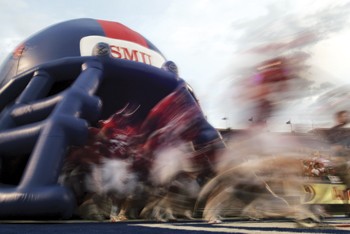
Over the past four years, the SMU athletic department has lost $56.7 million.
The department is projected to lose $16.8 million in 2008 and $16.3 million in 2009.
If those projections hold up, the SMU athletic department will have lost almost $90 million over six years, figures far larger than previously published estimates.
The number come from figures in university budget documents obtained by The Daily Campus.
Athletic Director Steve Orsini said meeting a budget and reining in the deficit are goals of his since he arrived in spring 2006.
“It’s important, but is it realistic?,” he said. “Only a handful of athletic departments do not have a deficit.”
A recently published NCAA report confirms Orsini’s statement. It analyzed the revenues and expenses of all NCAA Football Bowl subdivision (formerly known as Division I) schools in 2004, 2005 and 2006. Only 16 of the 119 schools reported profits.
But SMU’s losses are much larger than the median number for the other 102 schools. According to the NCAA report, the median loss for these schools was $6 million in 2004, $6.8 million in 2005 and $9.4 million in 2006.
By comparison, SMU lost $12 million, $13.72 million and $12.96 million in the same period.
In 2007, Orsini’s first full year at SMU, the deficit was $17.95 million.
Previously reported numbers had SMU’s deficit between $3 and $5 million each year, but those numbers underreport the financial drain of scholarship funds, which are included in the bottom line of athletic departments.
Christine Casey, SMU’s vice president for business and finance, agreed that self-sufficient athletic departments are hard to find.
“They’re on campuses for various reasons,” she said. “It’s a part of the experience and an important function on campus.”
“That being said, there’s always a limit to what you’re willing to do as far as supporting an activity and that’s a question that’s made internally every year.”
All budgets at SMU, including the one submitted by the athletic department, begin going through preliminary drafts in the fall and are due to Casey’s office by April. They are submitted for approval to the Board of Trustees at its May meeting.
Orsini said he takes seriously something President Gerald Turner said to him when he was hired – that he was to get the department in better fiscal shape.
“It doesn’t happen overnight,” Orsini said.
Orsini’s first budget as athletic director was in 2007 and had losses of $5 million more than the previous year, which was the final one for former athletic director Jim Copeland.
Three big items ballooned the deficit in 2007 – a $400,000 per year deal for basketball coach Matt Doherty, a $600,000 buyout for fired basketball coach Jimmy Tubbs and a contract extension upping Phil Bennett’s salary to $500,000 per year.
The 2008 and 2009 budgets are projected to have reductions in the deficit, but are still larger than losses in the Copeland era.
“What I noticed when I got here early on is SMU was falling behind in generating revenue,” Orsini said.
To that end he has worked to take advantage of what he calls missed opportunities for sponsorships. That means more advertisements at games, which fans probably noticed this past season, and increased partnerships with businesses for the department.
Orsini also has overhauled most of the leadership within various parts of the department so the people in charge have “more of a business focus.”
One item that will not cause additional hits to the budget is the salary of new football coach June Jones. More than $10 million was raised by Orsini for Jones’ annual salary of nearly $2 million and the assistants that came with him. The group that raised the funds is called the Circle of Champions and is solely underwriting those costs.
Orsini said the Circle of Champions model worked so well he wants to apply it to other areas of the department. He said it creates a sense of involvement in athletics that keeps people connected.
But ticket sales remain the biggest source of immediate income for the department. That’s where the product on the field will help with off-the-field money issues.
“Once they start winning people will support you more,” Orsini said.









